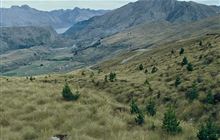Pressure going on runaway Central North Island pines
Archived content: This media release was accurate on the date of publication.
Introduction
Nearly half a million dollars is going into removing wilding pines from Central North Island conservation areas that were previously being over-run by the pest trees.Date: 07 January 2022
The Department of Conservation has been targeting wilding pines for many decades alongside Horizons Regional Council and volunteer groups, including the Wanganui and Hut Valley Tramping clubs.
These years of hard work have meant the unique features of the landscape have not been completely blanketed by wilding pines. However, Erua Conservation Area, Tongariro Conservation Area, Rangataua, and Tongariro National Park still have many wilding pines that need to be removed – and a $467,000 investment from the National Wilding Conifer Control Programme, through Biosecurity New Zealand (BNZ), a business unit of the Ministry for Primary Industries (MPI).
Danial van der Lubbe, site project manager for DOC Tongariro, said the work is being undertaken by local contractors and DOC staff, with potential for other existing ‘Jobs for Nature’ projects to also be involved.
“If left unchecked, wilding pines would infest the sensitive landscape of the Tongariro region and crowd out the fragile plant life in the area.”
“National Programme funding through MPI has allowed us to work in areas that previously we were not able to work on. It’s great to see both Horizons and DOC, with the endorsement of the iwi, working together to achieve important conservation outcomes.
“Working together we can prevent the spread of wilding pines and knock these invasive weeds off our maunga.”
One of the first jobs is to aerially-survey conservation areas to locate wilding conifers for follow up control activities. Control will then be either ground based (‘drill and fill’, ‘cut and paste’ or felling operations) or by aerial spraying.
Malinda Matthewson from Horizons Regional Council is the lead for the MPI Management unit “Tongariro” which includes both conservation and private land.
“Controlling wilding pines is achievable, but we still need to work consistently to manage them.
“Now that we have the National Programme this has really helped, as we have a better handle on where the trees are, and where the work needs to be done on a national scale.
“The relationships between DOC, Horizons and public groups have been very important in supporting the wilding pines work.
“This work could not be done without public support as well, and people now realise the importance of protecting our iconic landscapes.”
Wilding conifers or wilding pines are introduced trees that are spreading across the landscape through natural regeneration. They already cover more than 1.8 million hectares of New Zealand and, prior to the National Programme, were spreading at an estimated 90,000 hectares a year.
The National Wilding Conifer Control Programme was set up in 2016, taking a coordinated, collaborative approach to preventing the spread of wilding conifers.
Without the large-scale control undertaken by the Programme, 20% of New Zealand would be impacted by wilding pines within 20 years, resulting in the loss of native species and natural landscapes.
Contact
For media enquiries contact:
Email: media@doc.govt.nz

